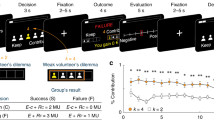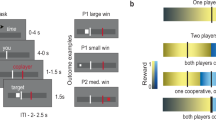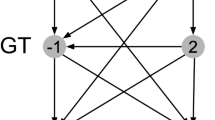Abstract
During competitive interactions, humans have to estimate the impact of their own actions on their opponent's strategy. Here we provide evidence that neural computations in the right temporoparietal junction (rTPJ) and interconnected structures are causally involved in this process. By combining inhibitory continuous theta-burst transcranial magnetic stimulation with model-based functional MRI, we show that disrupting neural excitability in the rTPJ reduces behavioral and neural indices of mentalizing-related computations, as well as functional connectivity of the rTPJ with ventral and dorsal parts of the medial prefrontal cortex. These results provide a causal demonstration that neural computations instantiated in the rTPJ are neurobiological prerequisites for the ability to integrate opponent beliefs into strategic choice, through system-level interaction within the valuation and mentalizing networks.
This is a preview of subscription content, access via your institution
Access options
Access Nature and 54 other Nature Portfolio journals
Get Nature+, our best-value online-access subscription
$29.99 / 30 days
cancel any time
Subscribe to this journal
Receive 12 print issues and online access
$209.00 per year
only $17.42 per issue
Buy this article
- Purchase on Springer Link
- Instant access to full article PDF
Prices may be subject to local taxes which are calculated during checkout






Similar content being viewed by others
References
Darwin, C. On the Origins of Species by Means of Natural Selection (Murray, 1859).
Hampton, A.N., Bossaerts, P. & O'Doherty, J.P. Neural correlates of mentalizing-related computations during strategic interactions in humans. Proc. Natl. Acad. Sci. USA 105, 6741–6746 (2008).
Devaine, M., Hollard, G. & Daunizeau, J. The social Bayesian brain: does mentalizing make a difference when we learn? PLoS Comput. Biol. 10, e1003992 (2014).
Camerer, C., Ho, T.-H. & Chong, J.-K. A cognitive hierarchy model of games. Q. J. Econ. 119, 861–898 (2004).
Schurz, M., Radua, J., Aichhorn, M., Richlan, F. & Perner, J. Fractionating theory of mind: a meta-analysis of functional brain imaging studies. Neurosci. Biobehav. Rev. 42, 9–34 (2014).
Behrens, T.E.J., Hunt, L.T. & Rushworth, M.F.S. The computation of social behavior. Science 324, 1160–1164 (2009).
Bhatt, M.A., Lohrenz, T., Camerer, C.F. & Montague, P.R. Neural signatures of strategic types in a two-person bargaining game. Proc. Natl. Acad. Sci. USA 107, 19720–19725 (2010).
Carter, R.M., Bowling, D.L., Reeck, C. & Huettel, S.A. A distinct role of the temporal-parietal junction in predicting socially guided decisions. Science 337, 109–111 (2012).
Mars, R.B., Shea, N.J., Kolling, N. & Rushworth, M.F.S. Model-based analyses: Promises, pitfalls, and example applications to the study of cognitive control. Q J Exp Psychol (Hove) 65, 252–267 (2012).
Hunt, L.T. et al. Mechanisms underlying cortical activity during value-guided choice. Nat. Neurosci. 15, 470–476, S1–S3 (2012).
Huang, Y.Z., Edwards, M.J., Rounis, E., Bhatia, K.P. & Rothwell, J.C. Theta burst stimulation of the human motor cortex. Neuron 45, 201–206 (2005).
Ruff, C.C., Driver, J. & Bestmann, S. Combining TMS and fMRI: from 'virtual lesions' to functional-network accounts of cognition. Cortex 45, 1043–1049 (2009).
Ruff, C.C. et al. Concurrent TMS-fMRI and psychophysics reveal frontal influences on human retinotopic visual cortex. Curr. Biol. 16, 1479–1488 (2006).
Coricelli, G. & Nagel, R. Neural correlates of depth of strategic reasoning in medial prefrontal cortex. Proc. Natl. Acad. Sci. USA 106, 9163–9168 (2009).
De Martino, B., O'Doherty, J.P., Ray, D., Bossaerts, P. & Camerer, C. In the mind of the market: theory of mind biases value computation during financial bubbles. Neuron 79, 1222–1231 (2013).
Amodio, D.M. & Frith, C.D. Meeting of minds: the medial frontal cortex and social cognition. Nat. Rev. Neurosci. 7, 268–277 (2006).
Clithero, J.A. & Rangel, A. Informatic parcellation of the network involved in the computation of subjective value. Soc. Cogn. Affect. Neurosci. 9, 1289–1302 (2014).
Zhu, L., Mathewson, K.E. & Hsu, M. Dissociable neural representations of reinforcement and belief prediction errors underlie strategic learning. Proc Natl. Acad Sci USA 109, 1419–1424 (2012).
Nicolle, A. et al. An agent independent axis for executed and modeled choice in medial prefrontal cortex. Neuron 75, 1114–1121 (2012).
Sack, A.T., Camprodon, J.A., Pascual-Leone, A. & Goebel, R. The dynamics of interhemispheric compensatory processes in mental imagery. Science 308, 702–704 (2005).
van den Bos, W., Talwar, A. & McClure, S.M. Neural correlates of reinforcement learning and social preferences in competitive bidding. J. Neurosci. 33, 2137–2146 (2013).
Hare, T.A., Camerer, C.F., Knoepfle, D.T. & Rangel, A. Value computations in ventral medial prefrontal cortex during charitable decision making incorporate input from regions involved in social cognition. J. Neurosci. 30, 583–590 (2010).
Haroush, K. & Williams, Z.M. Neuronal prediction of opponent's behavior during cooperative social interchange in primates. Cell 160, 1233–1245 (2015).
Suzuki, S. et al. Learning to simulate others' decisions. Neuron 74, 1125–1137 (2012).
Wunderlich, K., Dayan, P. & Dolan, R.J. Mapping value based planning and extensively trained choice in the human brain. Nat. Neurosci. 15, 786–791 (2012).
Tricomi, E., Balleine, B.W. & O'Doherty, J.P. A specific role for posterior dorsolateral striatum in human habit learning. Eur. J. Neurosci. 29, 2225–2232 (2009).
Tsakiris, M., Costantini, M. & Haggard, P. The role of the right temporo-parietal junction in maintaining a coherent sense of one's body. Neuropsychologia 46, 3014–3018 (2008).
Wold, A., Limanowski, J., Walter, H. & Blankenburg, F. Proprioceptive drift in the rubber hand illusion is intensified following 1 Hz TMS of the left EBA. Front. Hum. Neurosci. 8, 390 (2014).
Heinisch, C., Dinse, H.R., Tegenthoff, M., Juckel, G. & Brüne, M. An rTMS study into self-face recognition using video-morphing technique. Soc. Cogn. Affect. Neurosci. 6, 442–449 (2011).
Young, L., Camprodon, J.A., Hauser, M., Pascual-Leone, A. & Saxe, R. Disruption of the right temporoparietal junction with transcranial magnetic stimulation reduces the role of beliefs in moral judgments. Proc. Natl. Acad. Sci. USA 107, 6753–6758 (2010).
Carter, R.M. & Huettel, S.A. A nexus model of the temporal-parietal junction. Trends Cogn. Sci. 17, 328–336 (2013).
Geng, J.J. & Vossel, S. Re-evaluating the role of TPJ in attentional control: contextual updating? Neurosci. Biobehav. Rev. 37, 2608–2620 (2013).
Baron-Cohen, S. Theory of mind and autism: a review. Int. Rev. Res. Ment. Retard. 23, 169–184 (2000).
Baron-Cohen, S., Wheelwright, S., Hill, J., Raste, Y. & Plumb, I. The “Reading the Mind in the Eyes” test revised version: a study with normal adults, and adults with Asperger syndrome or high-functioning autism. J. Child Psychol. Psychiatry 42, 241–251 (2001).
Schaafsma, S.M., Pfaff, D.W., Spunt, R.P. & Adolphs, R. Deconstructing and reconstructing theory of mind. Trends Cogn. Sci. 19, 65–72 (2015).
Baumgartner, T., Knoch, D., Hotz, P., Eisenegger, C. & Fehr, E. Dorsolateral and ventromedial prefrontal cortex orchestrate normative choice. Nat. Neurosci. 14, 1468–1474 (2011).
Smith, D.V., Clithero, J.A., Boltuck, S.E. & Huettel, S.A. Functional connectivity with ventromedial prefrontal cortex reflects subjective value for social rewards. Soc. Cogn. Affect. Neurosci. 9, 2017–2025 (2014).
Ruff, C.C. & Fehr, E. The neurobiology of rewards and values in social decision making. Nat. Rev. Neurosci. 15, 549–562 (2014).
Johnson, E.J. & Ratcliff, R. Computational and process models of decision making in psychology and behavioral economics. in Neuroeconomics: Decision Making and the Brain (eds. Gimlicher, P.W. & Fehr, E.) 358–365 (Academic Press, 2014).
Button, K.S. et al. Power failure: why small sample size undermines the reliability of neuroscience. Nat. Rev. Neurosci. 14, 365–376 (2013).
Spiegelhalter, D.J., Best, N.G., Carlin, B.P. & van der Linde, A. Bayesian measures of model complexity and fit. J. R. Stat. Soc. Ser. B. Stat. Methodol. 64, 583–639 (2002).
Owen, A.M., McMillan, K.M., Laird, A.R. & Bullmore, E. N-back working memory paradigm: a meta-analysis of normative functional neuroimaging studies. Hum. Brain Mapp. 25, 46–59 (2005).
Bosch-Domènech, A., Montalvo, J.G., Nagel, R. & Satorra, A. One, two, (three), infinity, ...: Newspaper and lab beauty-contest experiments. Am. Econ. Rev. 92, 1687–1701 (2002).
Murphy, R.O., Ackermann, K.A. & Handgraaf, M. Measuring Social Value Orientation. Judgm. Decis. Mak. 6, 771–781 (2011).
Yarkoni, T., Poldrack, R.A., Nichols, T.E., Van Essen, D.C. & Wager, T.D. Large-scale automated synthesis of human functional neuroimaging data. Nat. Methods 8, 665–670 (2011).
Posse, S. et al. Enhancement of BOLD-contrast sensitivity by single-shot multi-echo functional MR imaging. Magn. Reson. Med. 42, 87–97 (1999).
Schmiedeskamp, H. et al. Improvements in parallel imaging accelerated functional MRI using multiecho echo-planar imaging. Magn. Reson. Med. 63, 959–969 (2010).
Grueschow, M., Polania, R., Hare, T.A. & Ruff, C.C. Automatic versus Choice-Dependent Value Representations in the Human Brain. Neuron 85, 874–885 (2015).
Ashburner, J. & Friston, K.J. Unified segmentation. Neuroimage 26, 839–851 (2005).
Harvey, A.K. et al. Brainstem functional magnetic resonance imaging: disentangling signal from physiological noise. J. Magn. Reson. Imaging 28, 1337–1344 (2008).
Hutton, C. et al. The impact of physiological noise correction on fMRI at 7T. Neuroimage 57, 101–112 (2011).
Kasper, L. et al. Cardiac artefact correction for human brainstem fMRI at 7T. Neuroimage 47, S100 (2009).
Kruschke, J.K. What to believe: Bayesian methods for data analysis. Trends Cogn. Sci. 14, 293–300 (2010).
Daw, N.D. in Decision Making, Affect, and Learning. Attention and Performance XXIII (eds. Delgado, M.R., Phelps, E.A. & Robbins, T.W.) 555 (Oxford University Press, 2011 ).
Ahn, W.Y., Krawitz, A., Kim, W., Busmeyer, J.R. & Brown, J.W. A model-based fMRI analysis with hierarchical Bayesian parameter estimation. J. Neuroscience Psychology Econ. 4, 95–110 (2011).
Fudenberg, D. & Tirole, J. Game Theory (MIT Press, 1991).
Grinband, J., Wager, T.D., Lindquist, M., Ferrera, V.P. & Hirsch, J. Detection of time-varying signals in event-related fMRI designs. Neuroimage 43, 509–520 (2008).
Eklund, A., Nichols, T.E. & Knutsson, H. Cluster failure: Why fMRI inferences for spatial extent have inflated false-positive rates. Proc. Natl. Acad. Sci. USA 113, 7900–7905 (2016).
McLaren, D.G., Ries, M.L., Xu, G. & Johnson, S.C. A generalized form of context-dependent psychophysiological interactions (gPPI): a comparison to standard approaches. Neuroimage 61, 1277–1286 (2012).
Acknowledgements
This study was supported by grants from the Swiss National Science Foundation (CRSII3_141965 and 105314_152891) to C.C.R. We thank the staff of the Laboratory for Social and Neural Systems Research for practical support.
Author information
Authors and Affiliations
Contributions
C.A.H. designed the study, collected data, performed analysis and wrote manuscript. S.S. performed analysis and contributed to the manuscript. R.P. performed analysis and contributed to the manuscript. M.M. contributed to TMS–fMRI procedure, collected data and contributed to the manuscript. J.P.O. designed the study and contributed to the manuscript. C.C.R. designed the study, contributed to data analysis and wrote the manuscript.
Corresponding authors
Ethics declarations
Competing interests
The authors declare no competing financial interests.
Integrated supplementary information
Supplementary Figure 1 Hierarchical Bayesian influence model
Graphical representation of the Hierarchical Bayesian influence model fitted to the data for each subject. Clear shapes indicate latent variables and filled shapes observed variables (in this case, the choice of the subject/employee Chyee and the choice of the opponent/employer Chyer). The index t denotes trial and s denotes subject. The same procedure was applied for fictitious play and Reinforcement learning where μ(s,t) depends only on Chyer and follows equation [8] and [3] respectively.
Supplementary Figure 2 Deviation from random responding
The population-level parameter P(Work) deviates from the Mixed-Nash Equilibrium of 0.5 for vertex-cTBS (pmcmc ≅ 0) and rTPJ-cTBS (pmcmc ≅ 0). Standard deviations are shown in black.
Supplementary information
Supplementary Text and Figures
Supplementary Figures 1 and 2 and Supplementary Tables 1–3 (PDF 528 kb)
Rights and permissions
About this article
Cite this article
Hill, C., Suzuki, S., Polania, R. et al. A causal account of the brain network computations underlying strategic social behavior. Nat Neurosci 20, 1142–1149 (2017). https://doi.org/10.1038/nn.4602
Received:
Accepted:
Published:
Issue Date:
DOI: https://doi.org/10.1038/nn.4602
This article is cited by
-
Neurocomputational mechanisms involved in adaptation to fluctuating intentions of others
Nature Communications (2024)
-
Causal phase-dependent control of non-spatial attention in human prefrontal cortex
Nature Human Behaviour (2024)
-
A levels-of-analysis framework for studying social emotions
Nature Reviews Psychology (2024)
-
Neural mechanisms underlying interindividual differences in intergenerational sustainable behavior
Scientific Reports (2023)
-
Interpersonal neural synchrony when predicting others’ actions during a game of rock-paper-scissors
Scientific Reports (2022)



